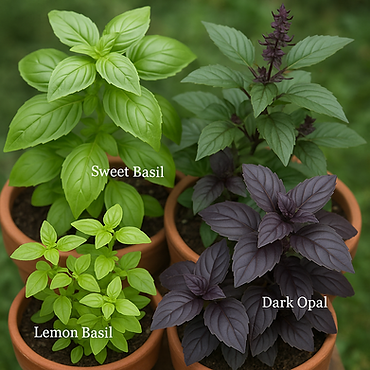Gardening Projects
At Green Thumb Hobbies, every season brings new opportunities to grow, experiment, and enjoy the beauty of gardening. Here, you’ll find a behind-the-scenes look at our latest endeavors—from nurturing tender bok choy in raised beds, to preparing for the vibrant colors of fall, to exploring the unique flavors and uses of different basil varieties. Whether you’re an experienced gardener or just starting your journey, these projects are packed with inspiration, tips, and a touch of dirt under the fingernails.

Why Basil Works So Well in Arizona Summers
One of the biggest challenges for gardeners in our region is finding plants that can handle the scorching summer heat. Many leafy greens bolt or wither, tomatoes pause fruiting, and even some herbs retreat until cooler days return. Basil, however, is a sun-lover that actually welcomes warm weather.
With consistent watering, well-drained soil, and at least 6–8 hours of direct sunlight, basil plants grow vigorously. In fact, the heat tends to intensify their flavor oils, meaning basil grown in Arizona sunshine often has a bolder, richer taste compared to plants grown in milder climates.
This resilience allows gardeners to plant multiple successions throughout the summer. By staggering sowing dates, we can enjoy fresh basil from June all the way into early fall, sometimes longer if nighttime temperatures stay warm.
Going Beyond Sweet Basil: Varieties We Chose
When most people think “basil,” they picture the glossy, bright green leaves of Sweet Basil. While this variety is delicious, it’s far from the only option. For our summer project, we decided to showcase a basil tasting garden—growing several varieties side-by-side to appreciate their differences and experiment in the kitchen.
Here’s what made the cut for our first planting:
Sweet Basil (Ocimum basilicum)
The classic choice for Italian cooking, with large leaves perfect for pesto, pasta sauces, and fresh salads. Mild, slightly peppery, and incredibly versatile.
Lemon Basil (Ocimum × citriodorum)
This variety has smaller, light-green leaves with a strong citrus aroma. It’s excellent for flavoring iced teas, cocktails, grilled fish, and even fruit salads. The lemony zing makes it a summer favorite for both sweet and savory dishes.
Lime Basil (Ocimum americanum)
Similar to Lemon Basil but with a sharper, more zesty lime fragrance. A fun choice for salsas, marinades, and tropical drinks. It pairs surprisingly well with chicken and seafood.
Thai Basil (Ocimum basilicum var. thyrsiflora)
Recognizable by its narrow leaves and purple flower spikes, Thai Basil has a licorice-anise flavor. It’s essential in many Southeast Asian dishes, particularly curries, stir-fries, and pho. Unlike Sweet Basil, Thai Basil holds its flavor better when cooked.
Dark Opal Basil (Ocimum basilicum ‘Dark Opal’)
With striking deep purple leaves, Dark Opal Basil adds beauty to the garden and the plate. Its flavor is similar to Sweet Basil but slightly spicier, making it a colorful garnish for salads and pastas.
Holy Basil (Tulsi) (Ocimum tenuiflorum)
A sacred herb in many cultures, Holy Basil is used more for tea and medicinal purposes than for cooking. It has a spicy, clove-like flavor and is valued for its potential health benefits.
Growing Basil Successfully in Summer
Basil is easy to grow, but in Arizona’s climate, a few extra steps ensure the healthiest plants and best flavor.
1. Choose the right location
Basil thrives in full sun, but in the hottest part of summer, a little afternoon shade can prevent leaf scorch. Raised beds or large containers work well, as they allow for better drainage.
2. Prepare the soil
A rich, well-draining soil mix is essential. We amend our beds with compost and a bit of perlite for aeration. Basil prefers soil that stays consistently moist but not soggy.
3. Water wisely
Deep watering two to three times per week is usually sufficient. Morning watering is best, giving plants a chance to drink before the heat sets in.
4. Pinch and prune
Regularly pinching off the top set of leaves encourages bushier growth and delays flowering, which can change the flavor. If flowers do appear, snip them off unless you’re saving seeds.
5. Harvest often
The more you harvest, the more basil grows. Take leaves from the top down, always leaving enough foliage for photosynthesis.
Culinary Adventures with Basil Varieties
One of the most exciting parts of growing different basil varieties is experimenting in the kitchen.
-
Sweet Basil → Perfect for pesto, caprese salad, tomato sauce, and herb-infused olive oil.
-
Lemon Basil → Delicious in lemonade, herbal tea, grilled shrimp, and light vinaigrettes.
-
Lime Basil → Adds zip to salsa verde, guacamole, mojitos, and tropical desserts.
-
Thai Basil → Essential for Thai curries, stir-fried vegetables, and Vietnamese pho.
-
Dark Opal Basil → Striking garnish for charcuterie boards, purple-tinted vinegar, and fresh salads.
-
Holy Basil → Steeped as tea, added to soups for medicinal properties, or blended into herbal remedies.
Even drinks get a flavor upgrade—basil can be muddled into cocktails, steeped into syrups, or simply floated in sparkling water for a refreshing summer sip.
Why This Project Matters
This basil project is about more than just growing herbs—it’s about discovery. It encourages gardeners to step outside the routine of planting the same variety year after year and instead explore the depth and diversity a single plant family can offer.
By experimenting with multiple varieties, you:
-
Expand your palate with new flavors.
-
Learn how different cultivars perform in your specific climate.
-
Gain inspiration for recipes you may have never tried.
-
Add beauty and diversity to your garden beds.
And, of course, there’s the satisfaction of knowing exactly where your herbs came from and how they were grown—free of pesticides and picked at their peak.



